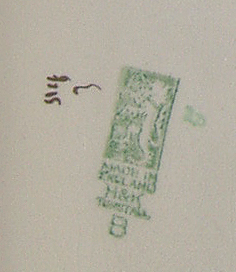HISTORY:
Originally established in Burslem, Staffordshire under the name Hollinshead & Kirkham (H&K) Ltd. In 1876 they moved to Tunstall and began operations from the Unicorn works in Tunstall in 1890. Known for their high quality earthenware and porcelain, especially hand painted designs on the latter. The company continued until 1956, at which time they were incorporated into the Johnson Bros group
H&K (Hollinshead & Kirkham) - Butter Dish
Trade Name: H&K TUNSTALL
Circa 1940's - product was for export under the Wartime Concentration Scheme, this is indicated by the B below the backstamp
Shape: square base plate with sloping lid
Opaque china, meaning that even when it is held to a strong light source, you cannot see the shadow of your fingers through the chinaware
Hand decorated (Artwork & Chinz Gold gilding)
The base colouring of both the lid and base plate is a cream colour, typical of the period (not bright White) with two areas of coloured hand painted scenes. To the front of the lid is a scene depicting the "lady of the house" in full attire, carrying a basket into which she is placing flowers of the meadow that she has picked. To the right of her is a pedestal bird house and in fact a small White bird is making it's way to this bird house. To the rear of the lid is another, different, scene which depicts a small collection of the meadow flowers. All colouring in both of these scenes is bright and vibrant. The remaining decoration on the lid is a chinz pattern of random shapes and some flowers or leaves, in created using Gold.
The base plate is much simplier in design, with two small areas of these hand painted meadow flowers and the remaining decoration all being the chinz Gold patterning. Some extra Gold gilding has been applied to the lid handle, along some seams and all around the edge rim of the base plate.
DIMENSIONS:
Base plate: 120mm x 165mm rectangular
Lid: 83mm x 115mm x 40mm height (lowest section) or 53mm (highest section)
The dish comfortably houses a "standard" 250g small brick of butter.
BACKSTAMP DETAILS:
This backstamp is easily identifiable as being produced during the years of WWII due to the B printed below the backstamp. The British Government placed strict controls on all industries during wartime, in an effort to maximise the availability of the workforce for the war effort and this government control was called the Wartime Concentration Scheme and was used right throughout the period 1940's ~ 1950's and in fact we believe this butter dish was intended for the export market, not local use.
The lid does not have the H&K backstamp, only the base plate, however both pieces clearly have the artist's mark and that of the Gold gilder.
Here is a picture of the backstamp, extracted from the base plate photograph

COSMETIC CONDITION:
The following description has a "general" application to BOTH sections of this butter dish, any differences and then mentioned below this general description.
Artwork is in good condition with no sections scratches or discoloured, the colours remain bright and vibrant even after 80 years.
The chinz patterned Gold gilding is also in good condition with no significant wear to any part, even the edges of the base plate, which would have seen the most handling.
NO chips
NO cracks of any type
CRAZING: Now here is where the signs of age creep in. Crazing is clearly visible on each section (very light cracks in the glaze only) This is not "unsightly" and we consider this to be very light. However, crazing allows moisture and the cultivation of nasty fungi to get underneath the glaze and flourish if not cared for properly ... fortunately there is only very light signs of this and the details are ...
LID: NO discolouration due to crazing on the top or sides however on the underside rim of the lid I can see a number of small Brown areas. Inside the lid is also free of any substantial discolouration.
BASE PLATE: On the top side of this plate (where the butter normally would rest) is a couple of "lines" which have turned a light Brown. The underside of this plate has no discolouration.
Both sections have been carefully washed AND sterilised (spray Iso Alcohol) to stop any fungi growth dead in it's tracks and prevent spreading of the discolouration in the future.














